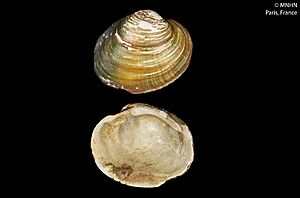Potomida littoralis facts for kids
Quick facts for kids Potomida littoralis |
|
|---|---|
 |
|
| Dried shell (syntype at MNHN, Paris) | |
| Conservation status | |
| Scientific classification | |
| Synonyms | |
|
Potomida littoralis is a type of bivalve, which is a mollusk with two shells, like a clam or an oyster. It belongs to the Unionidae family, often called freshwater mussels.
Where It Lives
This special mussel, Potomida littoralis, can be found in many places! It lives across Europe, around the Mediterranean Sea, and in parts of Southern Asia. You can also find it in Africa, specifically between Tunisia and Morocco. Interestingly, it hasn't been seen living naturally between Italy and Albania.
Life Cycle and Reproduction
Freshwater mussels like Potomida littoralis have an interesting way of reproducing. In places like the Iberian peninsula (Spain and Portugal), female mussels carrying eggs are seen from March all the way through October. The baby mussels, called larvae, usually hatch in September.
Protecting This Species
The Potomida littoralis mussel is in trouble. The International Union for Conservation of Nature says it is an endangered species, meaning its numbers are going down. Many things are harming these mussels:
- Water removal: Taking too much water from rivers and streams for human use is a big problem. This affects mussels in places like Portugal, Syria, Lebanon, and Israel.
- River changes: Making rivers into straight canals or building dams changes their natural flow. This destroys the mussel's home.
- Water pollution: Dirty water from human activities also hurts these sensitive creatures.
Because of these problems, the places where P. littoralis lives in the Iberian peninsula and France are now very spread out. This makes it harder for them to find mates and survive.


